« Prev Next »

Among my fondest memories are the summers that I spent studying the ants of Elk Island National Park in western Canada. Inside this wonderful Park, I might chance upon herds of elk or bison, a lone moose or a drumming ruffed grouse. All encounters were a thrill, but for me, the biggest thrill was encountering a raiding party of slave-making or dulotic ants. And if the slave-maker was Polyergus breviceps, a slave-maker on steroids, then I knew I was in for a spectacle.
Social parasites like P. breviceps are social insects that parasitize colonies of other social insects. These parasites are found throughout the social Hymenoptera (i.e., bees, wasps and ants), and have been most intensely studied in ants. The social parasitism that I address here is restricted to the ants that form mixed species nests and depend on labor provided by the host species workers. These nests typically have two or more species of ants in the colony, and can often be identified easily. For instance, many of the formicine slave-makers like P. breviceps are red ants that enslave other formicine ants which are black ants. Thus, when one opens a mound and sees red and black ants both in frantic distress, then one may have encountered slave-makers with slaves (Figure 1).
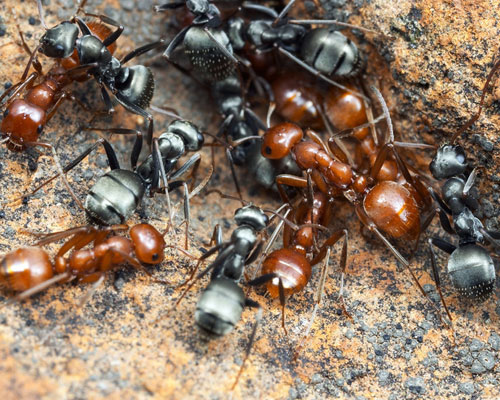
Types of Social Parasites
There are three main types of social parasites that form mixed species ant nests: temporary social parasites, permanent inquilines and slave-makers. Temporary social parasites depend on a host species only during the establishment of new colonies. Usually the parasitism is initiated by young queens following their insemination in a mating flight (Figure 2). The queens try to penetrate host colonies, replace the original queens, and gain acceptance by the workers. The parasitic queens then lay eggs that develop, with the care of the host colony workers, into a worker force of their own offspring. Eventually the host workers die leaving only the parasitic queens and their offspring. As a result, a mature colony contains only members of the parasitic species.
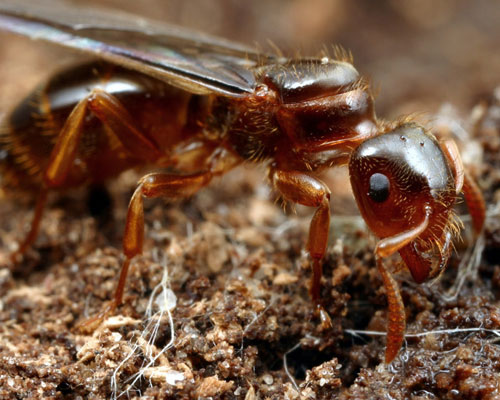
Whereas temporary social parasites typically kill the host queens, queens of permanent inquilines are usually tolerant of the host queens. With a few exceptions, inquilines do not produce worker offspring, but instead invest most of their energy into producing eggs that eventually develop into sexual forms. In the extreme case of the Swiss ant (Teleutomyrmex schneideri), the inquilines have evolved special modifications like concave abdomens (i.e., gasters) and long tarsal claws which enable them to grip onto the host queens and ride their backs as ectoparasites (Hölldobler & Wilson 1990). Despite the burden, the host queens continue to produce worker offspring and so the mixed species colony is permanent. The host workers simultaneously rear the brood of both the parasitic and non-parasitic queens.
The antics of the slave-makers have made them a favorite among myrmecologists. Besides initiating their nests much like the temporary social parasites, the slave-makers also raid other ant colonies to steal the brood (Figure 3). The pilfered larvae and pupae that are not consumed eventually eclose into worker slaves that are chemically imprinted and completely integrated into the society of their enslavers. The slaves tend brood, gather food, feed their enslavers, care for the queen, and defend the nest against threats. If the colony moves to a new location, the slaves carry their enslavers to their new nest. Sometimes, the slaves even participate with the slave-making workers in slave raids against other ant colonies of their own or closely related species.
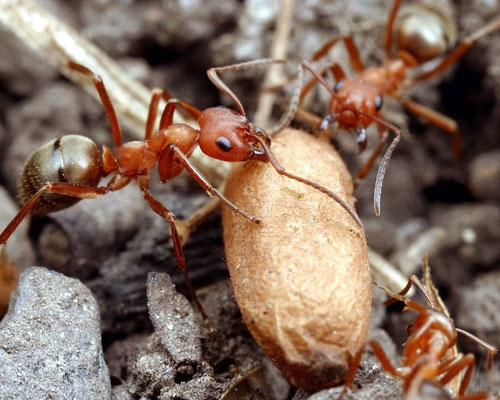
Not all slave-makers are equally adept at enslaving other ants. Facultative slave-makers like Formica subnuda are commonly found without slaves in their colonies. The slaves, if present, are small and comprise on average only about 10% of workers, because the slave-maker only successfully raids small incipient colonies of its host species. Further, slave raids by F. subnuda are met with great resistance by the host species, and thus the raids last for hours and mortality is high for both slave-makers and the workers of the raided colonies (Savolainen & Deslippe 2001).
In sharp contrast, obligate slave-makers like P. breviceps always have slaves that comprise even over 90% of the work force. They can successfully raid large colonies, sometimes several in sequence on a raiding day, and thus they have more slaves and larger slaves than facultative slave-makers. Their efficiency during raids is associated with special adaptations like enlarged glands and sharp sickle-shaped mandibles (Figure 4). Glandular secretions released during raids serve to pacify or turn workers from target colonies against each other, reducing aggression towards the slave-makers. Workers that do offer resistance to the slave-makers are readily immobilized with a quick piercing of the head or body with the mandibles. Although the modified mandibles of obligate slave-makers are effective weapons, they also make the slave-makers inept nurses and foragers, and incapable of managing their colony tasks without slaves. Indeed, P. breviceps cannot survive on its own even if plenty of food is available. This ant must have slaves to survive, and mature colonies must obtain a minimum of about 6000 slaves per season per colony to maintain a high proportion of slaves (Savolainen & Deslippe 1996).
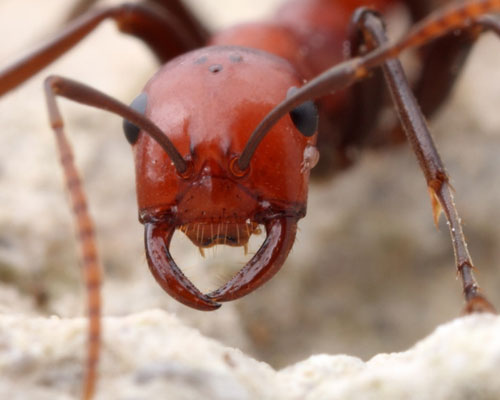
Colony Foundation
The main defense of ant societies is an intricate recognition system based on odors like those involving cuticular hydrocarbons (Martin & Drijhout 2009). This system allows for the rejection of alien nestmates from a colony and thus prevents takeover by unrelated individuals. Parasitic queens, regardless of the type of social parasitism, must all somehow usurp a host colony and gain acceptance within the colony. In some ants, the queens use stealth or brute force to penetrate host colonies during colony foundation. They may be met with aggression by the host workers, and may die in the attacks, but enough queens succeed to maintain robust populations. In other ants, the queens fight with workers of the host species outside the nest and obtain a chemical disguise via contact with the workers before entering the host nest, or they release their own chemicals from glandular secretions that serve to appease, mimic or camouflage. In some slave-makers, the queens return to their natal nest following the nuptial flight, then join a slave raid and establish a colony in an invaded host nest (Hölldobler & Wilson 1990; Lenoir et al. 2001; Buschinger 2009).
Except for most of the inquilines, the majority of social parasites directly or indirectly kill the host queens following their invasion. In the Polyergus species, the execution can be immediate, especially if the host colony contains a sufficient worker force (Topoff & Zimmerli 1993; Mori et al. 1995). These parasites attack only mated and egg-laying host queens, and in the process gain the cuticular hydrocarbon profiles of the attacked host queens that permits their acceptance by host workers (Johnson et al. 2002). In other ants, the execution of host queens can be delayed for weeks or even months. The parasite Leptothorax goesswaldi, for instance, penetrates a host colony in August following her insemination, waits in the nest until the next spring, and then slowly kills the host queen by cutting off her antennae (Buschinger & Klump 1988). In other genera, like the slave-makers Chalepoxenus and Harpagoxenus, even the adult host workers are either killed or evicted from the nest. New workers eclose from the conquered brood and they rear the brood of the parasite (Buschinger 2009).
Emery’s Rule
In 1909, the taxonomist Carlo Emery made an important generalization, now known as Emery’s rule, which states that social parasites and their hosts share common ancestry and hence are closely related to each other (Emery 1909). In the strict version of Emery’s rule, social parasites are their host’s closest relatives, and likely evolved from their host’s lineage by sympatric speciation, or through a combination of allopatric and subsequent sympatric speciation. In the loose version of Emery’s rule, social parasites are close relatives of their host, but not sister species (Bourke & Franks 1991; Lowe et al. 2002). Although few host-parasite pairs have been subjected to molecular phylogenetic analysis, studies to date support at least the loose version of Emery’s rule (Sumner et al. 2004; Smith et al. 2007). A notable exception is a documented case of social parasitism involving ants of different subfamilies (Mashwitz et al. 2000). In this case, the parasites had to overcome communication systems and pheromones that differ between themselves and their hosts, a situation which is less of a challenge when closely related species are involved (Figure 5).
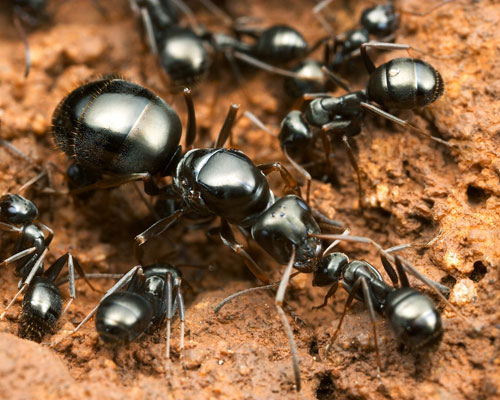
There are only about 230 known parasitic species of ants among the 12,500 or so described ant species. Despite their rarity, they are common in a few subfamilies like the Myrmicinae and the Formicinae (Buschinger 2009), and common in temperate ants but rare in tropical ants (Hölldobler & Wilson 1990). Why is there such a strong bias in both the taxonomic and ecological distributions of social parasites and their hosts? The selective forces and ecological conditions that favor social parasitism continue to be researched and discussed. Factors like cooler temperatures and polygyny (i.e., colonies with multiple queens) are important considerations, but can not explain the evolution of social parasitism in all cases.
References and Recommended Reading
Bourke, A. F. G. & Franks, N. R. Alternative adaptations, sympatric speciation and the evolution of parasitic, inquiline ants. Biological Journal of the Linnean Society 43, 157-178 (1991).
Buschinger, A. Social parasitism among ants: a review (Hymenoptera: Formicidae). Myrmecological News 12, 219-235 (2009).
Buschinger, A. & Klump, B. Novel strategy of host-colony exploitation in a permanently parasitic ant, Doronomyrmex goesswaldi. Naturwissenschaften 75, 577-578 (1988).
Emery, C. Über den Ursprung der dulotischen, parasitischen und myrmekophilen Ameisen. Biologisches Centralblatt 29, 352-362 (1909).
Hölldobler, B. & Wilson, E. O. The Ants. Cambridge, MA: The Belknap Press of Harvard University Press, 1990.
Johnson, C. A., H. Topoff, H. et al. Host queen killing by a slave-maker ant queen: when is a host queen worth attacking? Animal Behaviour 64, 807-815 (2002).
Lenoir, A., D'Ettorre, P. et al. Chemical ecology and social parasitism in ants. Annual Review of Entomology 46, 573-599 (2001).
Lowe, R. M., Ward, S. A. et al. The evolution of parasites from their hosts: intra- and interspecific parasitism and Emery's rule. Proceedings of the Royal Society of London B, Biological Sciences 269, 1301-1305 (2002).
Martin, S. J. & Drijfhout, F. P. A review of ant cuticular hydrocarbons. Journal of Chemical Ecology 35, 1151-1161 (2009).
Maschwitz, U., Borow, W. H. O. et al. Social parasitism involving ants of different subfamilies: Polyrhachis lama (Formicinae) an obligatory inquiline of Diacamma sp. (Ponerinae) in Java. Insectes Sociaux 47, 27-35 (2000).
Mori, A., D'Ettorre, P. et al. Host nest usurpation and colony foundation in the European Amazon ant, Polyergus rufescens Latr. (Hymenoptera: Formicidae). Insectes Sociaux 42, 279-286 (1995).
Savolainen, R. & Deslippe, R. J. Facultative and obligate slavery in formicine ants: frequency of slavery, and proportion and size of slaves. Biological Journal of the Linnean Society 57, 47-58 (2001).
Savolainen, R. & Deslippe, R. J. Facultative and obligate slave making in Formica ants. Naturwissenschaften 88, 347-350 (2001).
Smith, J. A., Tierney, S. M. et al. Origins of social parasitism: the importance of divergence ages in phylogenetic studies. Molecular Phylogenetics and Evolution 43, 1131-1137 (2007).
Sumner, S., Aanen, D. K. et al. The evolution of social parasitism in Acromyrmex leaf-cutting ants: a test of Emery's rule. Insectes Sociaux 52, 37-42 (2004).
Topoff, H. & Zimmerli, E. Colony takeover by a socially parasitic ant, Polyergus breviceps: the role of chemicals obtained during host-queen killing. Animal Behaviour 46, 479-486 (1993).






























